Daniel M. Russell's Blog, page 22
February 14, 2022
How to find anything #5: Assessing Credibility of News Sources
#8.3 Assessing Credibility of News Sources
Foreword: This is part two of our chapter on finding news (and late-breaking information). Mario Callegaro and I have been writing this to let you know some of the best practices in how to find online news. Here we talk about that important step--how to assess the credibility of a news source. How do you know when you should believe a new source?

When youâre looking for news sources youâll naturally want to find credible sources. The hard here is whatâs credible⦠and how can you spot a credible source? In other words, do you trust a source to be accurate even when you canât verify the claim yourself? Thatâs why you want to use credible sources: thatâs the trust you place in the source.
In other words, credibility is a measure of how much you trust the source to be accurate and honest about their reporting. Every news provider will make mistakes, but a credible provider will acknowledge them openly.
Brands are all about trust. That trust is built in drops and lost in buckets.
â Kevin Plank, Feb 21, 2014 â USA Today interview.
So, how can you identify a credible source?
I hesitate to give any checklist of features to look for two reasons:
Those lists tend to become out-of-date rather quickly, especially when different players start to game the system to appear more credible than they really are; and
The credibility of a source is built up over time and canât be determined by examining a single article.
(But if you want a checklist, here are a couple: the CRAP checklist, MLA checklist CXLâs checklist, Mike Caulfieldâs SIFT list. You know how to find more.)
How then can we identify credibility in the news we seek?
Hereâs the truth about credibility: Identifying a credible site takes time. Credibility, like trust, is easy to lose and difficult to gain. Yet thatâs what youâre doing as you read the newsâyouâre learning which sites have credible content. What all those checklists are saying is that credibility has many hallmarks, but none of them are completely diagnosticâtheyâre brush strokes that are trying to help you assess how believable you find the source. That is:
Credibility is created by sustained accurate and honest reporting by a news source. When a source is credible, the expectation is that the information being presented is accurate, and implicitly, you donât need to fact-check every detail.
A particular article might tick all the boxes in a âcredibility checklist,â it might have a byline, have citations, and present the information in a reasoned and verifiable way. It might have quotes that you can trace back to the original source, and present the information in a sober non-combative way. Those are all great features to have. But credibility is more complex than the presence or absence of those individual characteristics.
Recognize that news sources often have a composite nature (e.g. large paper will run editorials from different perspectives, and individual writers have different reputations). News sources are often not monolithic and through-written by an individual. Instead, the op-ed might well be written by an author with a very different perspective than the editorial stance of the site. Bear in mind that a single article might well be non-credible, but be found in a credible journal. (And vice-versa.)
So, what can one do to assess the credibility of a source? Here are some aspects to consider:
Reputation is variable: Credible sources tend to be well-known, they tend to cite each other, and they have a good mutual reputation. But bear in mind that different sources can have very different reputations in different communities. You might find the Wall Street Journal to be a credible source of economic information, but not to be a trustworthy advocate for economic policy positions. (I trust my Motherâs advice about our familyâs recipes, but not so much her thoughts on the economy.)
Check different versions of the story: When looking for a source of information on a given story⦠search for a range of sources in the area of interest. Get different perspectives on the story, and then see how your source stands up in the reporting. Are the facts consistent across different stories? How do different news sites tell the same story? The differences between stories by news source is often a useful guide to how to understand the siteâs credibility. Often, a news aggregator ( news aggregator, feed reader, news reader) will put different versions of a story side-by-side allowing for comparison reading.
A deep insight about news: Remember that âfactsâ of the moment are often transitory and are constantly being updated as new information is discovered. Keep this in mind as you wade through the news--our understanding of facts, what's going on, and how to interpret what we hear is constantly under revision.
Credible sites admit to errors: A site (or author) that never makes a mistake isnât doing reporting, theyâre writing religious tracts. Check for updates, errata, corrections on the site. Credible news outlets admit, identify, and correct their mistakes. Non-credible ones donât.
Pay for subscriptions: As you identify credible sources, we encourage you to pay for subscriptions to quality news sources (you will have your own list, but for example, my paid subscription list includes the New York Times, Wall Street Journal, Washington Post, The Atlantic, The Economist, The New Yorker). We also have some international sources such as BBC and Al Jazeera.
Fact-checking sites: When determining credibility of news sources, itâs often useful to have some some fact-checking sites in your credibility toolbox (e.g. Factcheck.org, Politifact.org, Washington Post Fact-check, AP Fact Check, FullFact.org, or Snopes.com). Remember that Wikipedia maintains a fact checking page by country.
Credible specialty sites: If youâre interested in speciality topics, youâll probably want to find reliable sites that cover only that topic area. You might be interested in the politics or your city/state/region/country, so we encourage you to spend some time looking at different perspectives on that topic. This advice is as true for math as it is for political stories. Different points of viewâeven about topics that donât seem to have different perspectives (e.g. math)--can be useful if only as a way to get different ways of telling the same story. For a completely different point of view (for us), we will sometimes check the Australian news services News.AU and the ABC (AU)
Finally, note that credibility is potentially transientâwhat you find a credible source NOW might not be a credible source next year. (They could have changed, or YOU could have changed. In either case, keep checking!)
The Can-you-tell-the-story? testOne of the simplest ways to self-assess whether a story is believable or not (and whether or not you understand the story and its sources), we often just try to tell-the-story to someone else. Imagine that youâre going to tell this story to your mother (or a friend, or whoever you trust). Can you actually tell the simplest possible version of the story and feel as though you can give an honest account of the story?
Itâs often the case that if you actually try to re-tell the story (or write it out), gaps in your understanding will often appear. Andâin particularâyou might well come to understand whether or not you should trust your news sources. Does the story make sense, or are there hard-to-follow claims? Do you understand all of the terms youâve used in telling the story to your trusted friend? Do you trust the sources that the news provider used in telling their story?
All of this will come to the front as you retell the tale. Can-you-tell-the-story? Itâs a simple sanity check. If you canât re-tell the story in a way that YOU believe, then you have to question the credibility of your sources.
What we do to keep track
Mostly, we collect reputable sites and authors. As we recommended in the previous post, keep track of the news sources that you find especially good. Some useful sites that we follow and have in our list of good sites are Techmeme (technology), Metacritic (reviews of movies), (e)Science News (for a feed of science news) and ScienceNews (for another perspective on science news). For health news we follow Healthline, or for business news Bloomberg, for example. Ask around within your community to learn what sources your friends and colleagues consider reliable and useful news sources.
Of course, your mileage may vary: itâs ultimately up to you to find your own useful and believable sites (and then keep track of them).
You can find your own news sites by searching for [ news site <topic> ] For instance, [ news site classical music ] will lead you to a bunch of newsy sites on that topic.
We also learn about authors as we read. When you find good (and credible) articles, take note of the author. Good writers tend to write multiple articles within a domain of expertise. Note their names and seek out their reporting.
___________________
And, just for extra, bonus points and a very different way to find news that you care about, check out theâ¦
Wikipedia Current Events Portal: The Wikipedia current events portal is an interesting way to get an overview of the worldâs stories without much commentary. There's one line for each major news story, including many international stories. There's even an archive feature (see red circle in image below) that can take you back to Jan 1994, although depth of coverage drops over time.
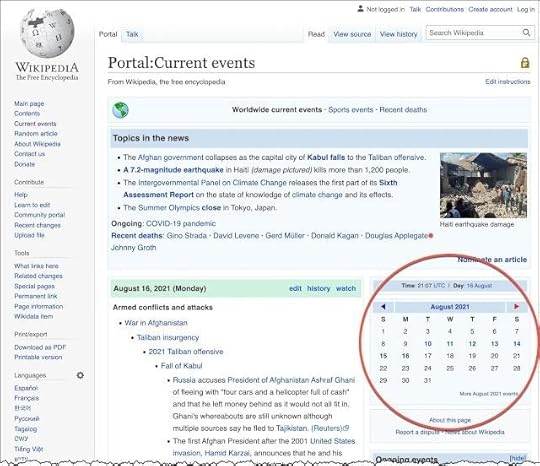
Search on!
February 10, 2022
Answer: Search in a world of changing names?
This flower has changed names...
 P/C Daniel M. Russell (2022)
P/C Daniel M. Russell (2022).. which is fairly common thing to do. People generally call this a shooting star, although I've always known this particular flower as Dodecatheon hendersonii, a name that rolls off the tongue (try saying it aloud!) and has a nice reference to the 12 gods ("dodecatheon") of the Olympian pantheon. It's also a fanciful name given by Pliny to a primrose purportedly protected by the gods.
But the name was changed to reflect newer phylogenetic information, which is only the right thing to do. Goodbye Dodecatheon, hello Primula, where it rejoins the rest of the primrose family.
This led me to frame these three name-changing Challenges. Can you figure out a search strategy for each?
1. Speaking of Mark Twain, did he use any other names besides Mark Twain for writing? (If so, what are they?)
We could do the Wikipedia search (which actually is a pretty good article). OR you could do a search like this, spelling out the variations on "pen name":
[ Mark Twain pseudonym ]
[ Samuel L. Clemens pen name ]
[ Samuel L. Clemens nom de plume ]
both of which will lead you to his aliases. But I wanted to find only his authorial names (that is, ones under which he published books or articles).
For something like that, I turn to the Library Of Congress online catalog, knowing full well that the catalog entry would also show me his pseudonyms.

That's a great find. BUT, as SRS Regular Reader Art showed us, it's often useful to look at multiple sources, each with a slightly different perspective. With his query of [ Mark Twain "other names" ] he found a few additional resources, including this one from World History Edu about Mark Twain. From that page he learned that Twain also wrote as âJoshâ and as âThomas Jefferson Snodgrass.â But the first time he used a pen name was in the early 1850s when he signed a sketch in his brotherâs newspaper âW. Epaminondas Adrastus Perkins.â
Of course I checked, and sure enough, I found that Clemens had also written with these other names. So it's clear we need to dig deeper.
Pro tip: If you look at the Wikipedia entry for Mark Twain, near the bottom you'll see some expandable sections including one called "Authority Control." I looks like this:

If you click on the [show] button on the far right, it will expand and show you multiple authority control links:

The first row (General) are links to different "Authority Control" web pages. If you click on WorldCat, you'll land on the OCLC WorldCat authority control page for Mark Twain / S. L. Clemens. Looks like this:
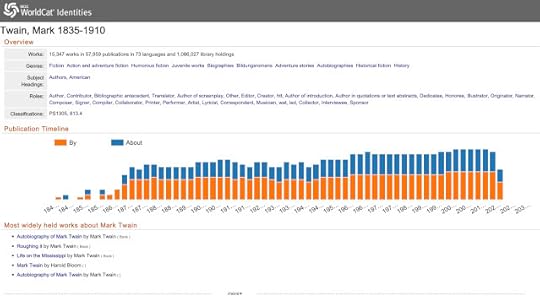 WorldCat identities authority record for Mark Twain
WorldCat identities authority record for Mark Twain(What is WorldCat? It's a meta-library catalog (technically, a "union catalog") that includes the catalogs of over 15K libraries worldwide. As you can imagine, like all libraries, they need to have an authority control system so you can find all of the works by the same writer, no matter if they changed names or write in a different writing systems. This get complicated when authors come from another orthography. For example, see the WorldCat record for Lao Tzu.)
Scroll down a bit on this page and you'll find the complete list of alternative names that Clemens used:
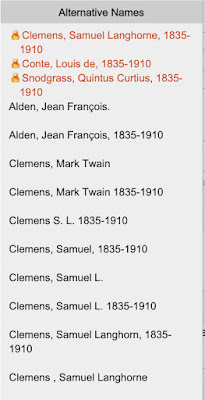
This list goes on for quite a while. When you think about it, that makes sense because the works of Mark Twain also appear in other orthographies such as Chinese, Korean, Arabic, Hebrew, Russian, etc. Farther down this list you'll find:

As I read through the list, I'd heard of most of his pseudonyms (as seen above), but was surprised to see the name Jean François Alden on the list. Is that really another pen name?
Life is complicated. Searching for this name reveals that the book "Personal Recollections of Joan of Arc, by the Sieur Louis de Conte" is an 1896 novel by Mark Twain which recounts the life of Joan of Arc. The novel is presented as a translation from the French by one "Jean François Alden" of memoirs originally written by Louis de Conte, a fictionalized version of Joan of Arc's page Sieur Louis de Contes.
So, Mark Twain (Samuel Clemens) wrote the book, but had a fictional memoir writer (de Contes) whose work was (fictionally) translated by Jean François Alden. Is that a pen name? Or is Alden just another character in a book by Twain? I can see it either way, and apparently, so can the Library of Congress, since they also listed Alden in their authority record!
Have we found ALL of the pen names of Twain/Clemens/Josh/Snodgrass? It's hard to know because Twain was such a prolific writer that a complete compendium of his work is nearly impossible to compile. He was an active writer and wrote copiously, often in obscure newspapers, sometimes changing pseudonyms at the drop of a hat. Researchers has recently rediscovered some of his works in 2015. (See this article from the Guardian about the Mark Twain project at UC Berkeley, where they KEEP finding more articles!)
So, for Clemens we have Quintius Curtius Snodgrass, Thomas Jefferson Snodgrass, Josh, W. Epaminondas Adrastus Perkins, Sieur Louis de Conte, and Jean François Alden. But I have no doubt that we'll find more pseudonyms as bibliophiles continue to find more of his writings.
2. You know that Istanbul was once known as Constantinople (there's even a song about that!), but what was Saint Petersburg, Russia (that is, the city of СанкÑ-ÐеÑеÑбÑÑг) called before its current name?
I began with the simplest possible search: [ Constantinople ] and read a few pages (including the inevitable Wikipedia page) where I learned that Constantinople appears in many orthographies, thus, in Greek: ÎÏνÏÏανÏινοÏÏÎ¿Î»Î¹Ï (KÅnstantinoupolis), Latin: Constantinopolis; Ottoman Turkish: ÙسطÙØ·ÙÙÙÙâ, romanized as: Ḳosá¹aná¹Ä«nÄ«ye).
It was the capital of the Roman/Byzantine Empire (330â1204), the Latin Empire (1204â1261), and then back to the Byzantine Empire (1261â1453), and the Ottoman Empire (1453â1922). Officially renamed as Istanbul in 1930, the city is today the largest city and financial centre of the Republic of Turkey
What was it before 330?
In 657 B.C., the ruler Byzas from the Greek city of Megara founded a settlement on the western side of the Strait of Bosporus, which linked the Black Sea with the Mediterranean. Thanks to the pristine natural harbor, his self-named city--Byzantium (Ancient Greek: ÎÏ Î¶Î¬Î½Ïιον, Byzántion)--grew into a thriving port city. It kept that name until 330 CE when Constantine consecrated the empire's new capital there as New Rome (Nova Roma), a city which would one day bear his name. Constantinople would become the economic and cultural hub of region. Its importance would take on new meaning with Alaric's invasion of Rome in 410 CE and the eventual fall of (old) Rome to Odoacer in 476 CE.
In this case, my search strategy was simple: begin with the obvious search, and then read 5 or 6 different sources (in particular, ones that are NOT duplicates of each other), and look for the points of agreement. I found these earlier names (Byzántion and Nova Roma) in multiple places with links to various histories of Turkey and Istanbul, so I'm pretty confident that these are the earlier names.
Applying the same search technique to St. Petersburg tells us that it was founded on May 16, 1703, at the mouth of the Neva, not far from Nien at the site of a captured Swedish fortress by Tsar Peter I (aka Peter the Great). Later, the name was changed to Petrograd (1914â1924) and then Leningrad (1924â1991), before reverting to St. Petersburg in 1992. (For reference, I used the Russian St. Petersburg Wikipedia page with Google Translation.)
3. What were projected moving images (what we would now label a "movie") called before 1900?
For this I took a historic approach with a search for:
[ history of movies ]
and landed on the Wikipedia page for the History of Film along with its related articles History of Film Technology, Precursors of Film. While around 1659 the magic lantern was developed by Christiaan Huygens to project still images, it took a while to get the tech working for moving images. But I will leave you to read about the detailed history. (Fascination warning: You might go into the rabbithole of old film mechanisms and never emerge.)
images. We could spend many happy hours reading about the early motion image systems, but here's a list of the ones I found: Bioscop, Zoetrope, Théâtre Optique, Phenakistiscope, Kinetoscope, Zoopraxiscope, Praxinoscope, etc.
And, of course, my favorite image from this era (not a projected image, but the first motion capture):
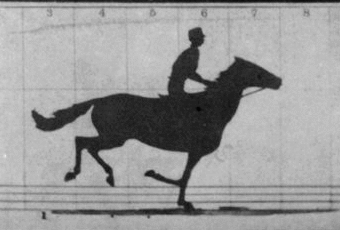 The Horse in Motion. A GIF of E. Muybridge's still photos of a
The Horse in Motion. A GIF of E. Muybridge's still photos of aracehorse running past the Red Barn on Stanford campus.
1878 (P/C Wikimedia)
1. An authority file has the "master record" of an author's names, pen names, pseudonyms, and spellings in other languages. WorldCat and the LOC have the best authority file, but they're still a little wonky to use. (I'll write another article soon about how to use them effectively.)
2. Even so, it's worth looking around for other pseudonyms. The authority files might not be conclusive. (As we found with "Josh" as a pen name for Twain.)
3. When searching in other orthographies (e.g., Russian), it's useful to consult multiple sources, including those in the original language. Thank heavens for Google Translate. For dataful queries like this, it's a fantastic resource.
Search on!
February 2, 2022
SearchResearch Challenge (2/2/22): Search in a world of changing names?
Last week I took this photo of a
beautiful woodland flower...
 P/C Daniel M. Russell (2022)
P/C Daniel M. Russell (2022)I've always known this particular flower as Dodecatheon hendersonii, aka, a "shooting star" or "mosquito bills."
If memory serves me correctly, this flower typically blooms in mid-February through mid-April. So I went to check this in the CALFLORA website and was surprised to see a little notice in a pink highlight: "No longer an active name."
Really? I know that flowers (and many animals) are under constant revisions as biologists learn more about them, usually with improved molecular genetic testing. But I was surprised to learn that this flower has been recategorized into the Primula family, making its new binomial name Primula hendersonii!
I did the search for this flower in the Jepson Manual (the authoritative source of plant names in California) and learned that the official name change happened in 2007 with the publication of "Transfer of Dodecatheon to Primula (Primulaceae)" by Mast, A. R., & Reveal, J. L., Brittonia, 59(1), 79-82 (2007).
Boy did I feel out of touch!
But it brought up an interesting question of how things change names over time and how we manage to navigate the shifting sands of names in our searches.
Luckily, many (most?) publications will publish the original name as a synonym (or alias) along with the new name.
The real question for us as searchers is suppose you don't know of the name change... how do you search then?
This becomes an issue the farther back you go in time. You might recognize Londinium as an earlier name of London, and you know that Firenze is the Italian name for the city of Florence. You might know that Mark Twain is another name for Samuel L. Clemens (the author), but did he use another other names?
Here are three versions of alt-names that have been used for people, places, and things. Can you figure out a search strategy for each?
1. Speaking of Mark Twain, did he use any other names besides Mark Twain for writing? (If so, what are they?)
2. You know that Istanbul was once known as Constantinople (there's even a song about that!), but what was Saint Petersburg, Russia (that is, the city of Санкт-Петербург) called before its current name?
3. What were projected moving images (what we would now label a "movie") called before 1900?
It shouldn't take you long to answer these Challenges, but I want to learn HOW you found the answers. Did you use a particular resource to get an answer?
Search on!
January 28, 2022
How to find anything #4 (part 2/3): News and Late Breaking Information - how to keep track
How to find: News & Breaking Events: Keeping track of your news sources (part 2)
Foreword: This is part two of our chapter on finding news (and late-breaking information). Mario Callegaro and I have been writing this to let you know some of the best practices in how to find online news. Here we talk about that important step--keeping track of the sources you find useful!_____________________________________________________________
Key tip: Keep a list of your favorite sources
There are millions of news sites—how do you deal with them all?
Answer: People usually create their own lists of news sources and sites and apps that they visit to follow breaking events.
Most news sites have email subscriptions that can deliver a regular stream of news to you (in addition to you visiting the site). Bear in mind what your preferred type of news is. How do you want to consume your news? There are news websites, news email lists, news apps, you can subscribe to video news services, podcasts, vlogs—you name it, and it’s out there.
Often, frequent searchers will have subscriptions (which we encourage) to the sites they visit during their news reading. Many news sites also have email feeds that you can set up to see the breaking stories that you’d like to track. Keeping track of all that in your head is impossible. We recommend making a list of your top sites (a Google Doc is a simple way to do that).
What do you put into your Doc list of news? Here are the key kinds of sources:
1. News providers
There are lots of news providers, many with their own apps: Cleveland Plain Dealer; Times of London; Boston Globe; El Universal (Mexico); El Pais (Spain); Dainik Jagran (India); etc etc etc... Find one that’s close to you and subscribe.
2. News providers with videos
Note that many news outlets have video streams as well (see, for instance New York Times Videos or Washington Post videos), and of course your local television news source usually has a YouTube channel (or some other kind of way to pump out news videos).
In addition to these, many news providers also have YouTube channels that don’t carry exactly the same content. (Examples: Washington Post YouTube channel.)
And of course, some news providers are primarily video creators and only have written forms as alternative ways of presenting information. (Think about ABC, CBS, NBC in the US, or BBC World News in the UK.)
3. Aggregators
A news aggregator collects news from multiple sources into a simple to use format. They have their own news scanning and ranking algorithms. This is really a collection of stories pulled together from other places:
Apple News (subscription required)
Google Discover — news aggregation on your mobile device that’s tailored by your searches and expressed interests
4. Wikipedia
In addition to all of the normal news sources, the Wiki-world has its own set of resources to tap into. If you haven't seen these, it's worth a look to get another perspective on the news and what resources are available.
List of news sources worldwide - lists ONLY news resources, organized geographically. This isn’t a list of all newspapers, just websites with news coverage.
List of newspapers - geographically organized. Fairly complete. (Includes lists of defunct newspapers, not all of which are still online, but still readable via the Internet Archive.)
List of TV news - global, geographically organized.
5. Realtime news sources
While the global news cycle is increasingly nearly real-time, sometimes you might want to get up-to-the-second news. This is a common need during disasters and calamities of all kinds. (Most recently, Dan was monitoring the wildfires in California and the follow-on effects of the smoke that drifted everywhere.)
In these cases, you’ll want to consider real-time sources like Twitter, WhatsApp, Telegram, and Facebook. The one thing to remember in all of these real-time sources is that you probably do NOT want to watch the raw stream of updates from random posters. Disasters often create a flood of incorrect and misinformation: be very cautious. We recommend that you find authoritative sources that have a good reputation beforehand. Many official government sites will provide official feeds. The drawback of these sources is that they’re often slow and will give the official story. IF you can find a reliable news provider ahead of time (e.g., your local newspaper or on-the-spot news provider, such as the BBC), you’ll want to follow their various channels.
If you’re interested in where people get their news, the Pew organization released the results of their survey about news sources from social media in 2021. Bottom line: Less than 50% of Americans get news from social media, and of those that do, less than 10% of Americans say they regularly get news from Reddit (7%), TikTok (6%), LinkedIn (4%), Snapchat (4%), WhatsApp (3%) or Twitch (1%). At the same time, about 31% read Facebook for news, while 22% turn to YouTube.
WAYS TO HOLD ONTO YOUR NEWS LINKS:
Bookmarks - you know, you can use the regular old bookmark manager in your browser. (Bookmarks in Chrome; Bookmarks in Firefox)
URL managers (aka Bookmark Managers) These are, basically, fancy bookmark managers; often run as a separate app on your phone. You can set up a tab with just the news feeds you want to check.
Just plain notes. This is what I do—I have a document with the links I want to check every so often. I also have a little note next to the link with features (e.g., editorial writers that I like, or special sections and topics). You can use Google Docs or Microsoft Word. A key question for notes: Should you include the entire URL in plain text? I would say yes, just in case something bad happens and your links go bad. With the full URL you can still get to the destination. (Why do I keep my news links in a plain text file? Answer: So I can pick up my links and move to another kind of browser or computer system without any hassle. Moving a single file (that has exactly the information you want) is much easier than figuring out how to export bookmarks from one browser and maybe importing them into another kind of browser.)
NEWS FLASH: Links go bad. You should know this by now: note that links (especially to news stories) often go stale. When that happens, your news link won’t work any more. News organizations will sometimes move their content around breaking a formerly working link. Sometimes that content gets put behind a paywall and you have to pay for it.
So… Save what you care about: IF the news content is important to you (e.g., critical to some research you’re doing), consider saving the entire web page WITH the URL with time-date stamp by saving it as a PDF (here’s how) or as an MHT (web-page complete, here’s how) file. I can’t tell you how often I’ve lost valuable bits of information because a link went bad or a site disappeared. If it matters, save it. Storage is cheap—pulled-out hair is painful.
Simplifying reading of news (or other web pages): You probably have noticed that reading news pages is often an annoying proposition because some news sites carpet-bomb their pages with ads and flashing doodads of every possible kind. You can use reader mode to simplify your reading of the page. If you find yourself annoyed by all of the visual clutter, here’s how to activate the Reader Mode for your browser: Chrome, Safari, Firefox, Edge.
As an example, here’s a side-by-side comparison of an article from the NYTimes in Reader mode vs. in full-view mode--they're very different presentations:

You can control your news feeds and the way in which you read. Use Reader mode if you find yourself getting distracted while doing your research.
But however you do it, be sure the content is believable. We’ll show you how in the next installment of “How to find anything,” the News edition, part 3.
Search on!
January 26, 2022
Answer: Time and tides in different places?
This was a curious question...
 The tide comes in near Gualala, California. P/C Dan.
The tide comes in near Gualala, California. P/C Dan.... which is my very favorite kind of question.
This Challenge really started from a chance observation ("the times of the tides are different here vs. there") and then a bit of a thought experiment ("what would it be like if the tides were the same everywhere").
When I thought it through, I realized that I'd never really considered how tides work at different places around the world. It was something to see that different places on the west coast of North America have different tides at different times. Of COURSE they must be different (I realized)--there's no way that high tide in Juneau, Alaska could happen at the same time as in Cabo San Lucas, Mexico (at the very bottom of the Baja peninsula).
And then, because this is the way thought experiments work (at least in my head), I wondered when high tide would happen if I looked westward. What time is the tide in Hawai'i or Japan? And of course, there's no way the tides on the east coast are the same as those on the west coast.
That's when I had my AHA moment--tides are complicated--and that's what led to this week's Challenge.
1. Is there some way to understand how the tides move around on the planet? If the time of high tide varies so much on the west coast of North America, there must be a similar variability in low tides at different locations. Is there some way to understand how tides vary over the course of a day? What's the best way to get an understanding of this global behavior?
I tell you what I did, and then review some of the responses in the comment thread.
My first thought was to get some kind of global visualization of the tides over time. That is, I was looking for some kind of animation to make the tidal changes over time AND space very apparent.
When I think of animation, I turn to YouTube. There, I did a search for:
[ global tides ]
and found this truly remarkable video from NASA:
Global tides animation video from NASADownload the video from their site (Barotropic tides)
It's worth watching this video a couple of times to notice the patterns. If you focus in on the northern Pacific Ocean, you can see the tides rotating around the Pacific basin like clockwork. (White is high, black is low.) Notice how the white blob saunters up the west coast of North America (the high tide), followed by a black blob. If you look carefully, you can even see the large high tide followed one cycle later by a lower high tide.
The video is also worth listening to as they give a nice summary of what's going on here. This is the transcript (lightly edited) of the video:
Ocean tides are not simple. If our planet had no continents, tides would be hemispheric-sized bulges of water moving westward with the moon and sun.
This animation shows the tides as a complex system of rotating and trapped waves with a mixture of frequencies. In many oceans we see waves rotating clockwise or anticlockwise, with small amplitudes in the middle of the ocean and high amplitudes around the boundaries, especially along the coasts of northwest Europe and Britain.
Waves are trapped and rotating around New Zealand, causing a high tide on one side of the islands with a simultaneous low tide on the other side. The Topex/Poseidon and Jason satellite altimeter missions were designed to observe and record this complexity.
Altimeters on these missions acted as flying tide gauges. And after several years collecting data, researchers could analyze the signals at each ocean location to determine the tidal characteristics.
With that knowledge, plus near-perfect knowledge of the motion of the sun and moon, the tide can be predicted at any location and at any time in the future.
Note that the large short-scale waves on continental shelves and marginal seas, as well as polar regions outside the orbits of Topex and Jason, and are still inadequately known. Scientists expect that SWOT (Surface Water and Ocean Topography satellite) will provide wide-swath altimeter readings that will help improve tidal knowledge in these regions. (SWOT is due to launch in November, 2022)
As the narrator points out, take a close look at New Zealand--the tides really do race around the island, with high tides on one side and lows on the other. It's a truly remarkable difference over a relatively short distance.
Also take note of the crazy tides in northeastern bays of Canada (such as Hudson Bay) and off the east coast of Argentina near Tierra del Fuego. This side-by-side capture of two video frames (roughly 6 hours apart) shows the high/low tides, and you can clearly see the variation.
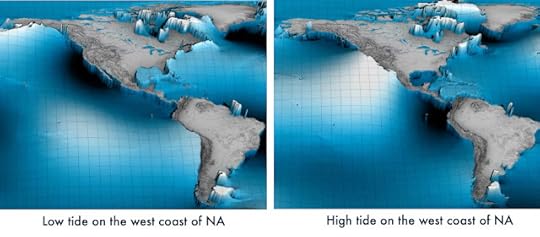
Bottom line: Tides are a world-wide phenomenon. You have to take a large-scale perspective to see what's going on... and why tides and time vary so much between San Diego and Juneau.
---
We had a bunch of comments on this topic, which happily surprised me. I had no idea so many people were interested in the tides. A few cherry-picked summary comments:
Arthur points out that "The specific features of a coastal location can affect how water moves, creating a lag that influences the times of the tide and other conditions. These variations give each coastal location a unique tidal pattern." He also points us to this remarkable time lapse of the extremely large tides in the Bay of Fundy (one of those NE Canadian bays). Worth a look:
Original video by Nova Scotia Webcams
Jon tells us that "On the west coast of North America the returning tide is forced by the Coriolis effect of Earth's rotation to be pushed to the right--landward-- as it races from the equatorial region at 700 mph to the north." (Details about the Coriolis effect, if you're a curious person. And no, the Coriolis effect doesn't make your bathroom drain turn one way north of the equator and the other way south of the equator.) Interesting thing to consider: Why doesn't the tidal motion go clockwise in the southern hemisphere? (Another Challenge?)
Remmij gave us the delightful discussion of oceanic whirlpools (e.g., the Old Sow, a whirlpool in the Bay of Fundy), and a pointer to how the big waves form off of Nazare, Portugal. (A video showing crazy surfers on those waves.)
Remmij also brought up the idea of creating mathematical models of tides with dynamic systems. A wonderful topic, but a bit beyond what we'll cover here. To see a model of the tides (and not the actual data), you might enjoy this animated tide model--compare it to the actual data visualization above.
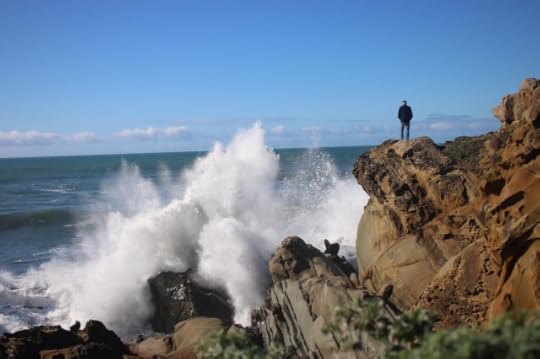 Dan standing on the rocks at high tide near Gualala, CA, pondering time and tides. P/C K. Russell
Dan standing on the rocks at high tide near Gualala, CA, pondering time and tides. P/C K. Russell
1. When looking for animated visualizations, check video sources first. When people publish their work with visualizations of things like sea-level data, it's common to push out a video of their work.
2. Sometimes the simplest query can open up the topic. In this case, just searching for [global tides] was enough to shift the focus from "just the west coast" to a larger, more global phenomenon.
3. Curiosity leads to many things worth learning. In this case we started with a simple observation, but now we've got a lot of additional questions that come out of this topic. Following your curiosity is a great way to get into a deeper understanding of the world we live in. For instance, something that has bothered me for a while: why do we have TWO tides each day? (Look for a future Challenge on this!)
Search (curiously) on!
January 19, 2022
SearchResearch Challenge (1/19/21): Time and tides in different places?
I was at the sea the other day...
 The tide comes in near Gualala, California. P/C Dan.
The tide comes in near Gualala, California. P/C Dan.As usual, I had looked up the tides before going, so I'd know when both high and low tide were to happen. That's an easy query on Google. If you do:
[ tide chart ]
Google will return a list of local tide chart sites, like this (my query here was done from Palo Alto, CA):
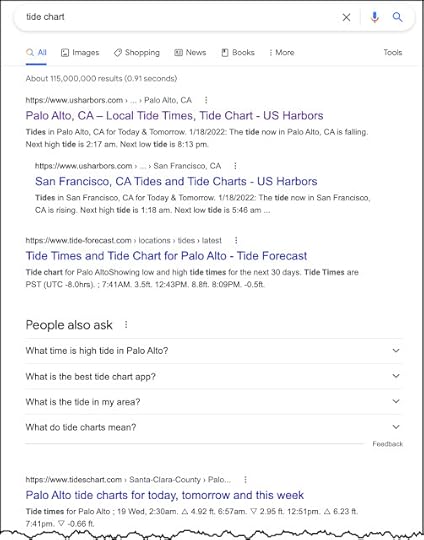
And if you click on the first result, you'll see a beautiful chart of the tides near you:
 Chart from USAHarbors.com
Chart from USAHarbors.comAs it happens, the other day when I went for my seaside walk, I was near Gualala, California, and I'd looked up the tide chart, which looked like this:
 All charts in this style are from TidesChart.com
All charts in this style are from TidesChart.com On Jan 14, the first low tide was at 1:49AM while the first high tide was at 7:59AM; second low tide was 2:35PM and second high tide at 10:36PM.
In one of those serendipitous moments that defines SearchResearch, I just HAPPENED to have looked up the tide chart for San Diego earlier that morning (I was looking up something else, don't you know...). So when I saw this chart for Gualala, it struck me that the time of the tides were different!
As I've often said, noticing small inconsistencies in the world often leads to curious outcomes. This is one of those.
Here's the tides chart for three locations on the coast of North America, San Diego (just above Mexico), Gualala (one quarter of the distance to Alaska), and Juneau, Alaska (way up north). See the map down below.
That's when I noticed--for the first time--that the tides seem to arrive later and later the farther north you go. To see this, look at the first high tide peaks: San Diego at 6:48AM, Gualala at 7:59AM, Juneau at 10:41AM. Apparently, the tides seem to arrive about four hours later. The distance, as the jet plane flies, is about 1947 miles (3134 kilometers) between San Diego and Juneau, so it seems the "tide" apparently travels at around 486 mph from south to north (787 kph).)

Realizing that the tides don't all go up/down at the same time along the west coast of North America was a surprise. I'd implicitly assumed that they all went up and down at the same time. (A moment's reflection makes me realize that can't possibly be true.)
BUT... it leads to today's SRS Challenge:
1. Is there some way to understand how the tides move around on the planet? If the time of high tide varies so much on the west coast of North America, there must be a similar variability in low tides at different locations. Is there some way to understand how tides vary over the course of a day? What's the best way to get an understanding of this global behavior?
When I did this Challenge, I was happily surprised to find that there are some beautiful ways to understand this. Perhaps you can find them as well? (I guarantee that this is an easier problem that the Skytree shadow!)
Let us know what you found to answer this Challenge and HOW you found it!
Search on!
January 18, 2022
How to find downloadable books in Google Books
All I wanted was a full-view version of Audubon's masterpiece, The Birds of America...
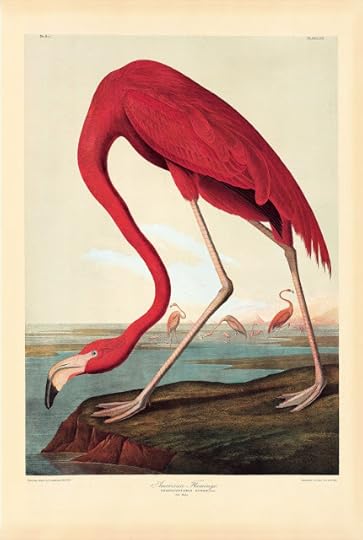 A page from Audubon's "Birds of America"
A page from Audubon's "Birds of America"... but I was having a hard time findingi it. But with a little help from my friends on the Books team, I learned how to do this.
1. Do your search and limit the returns to "Full View"
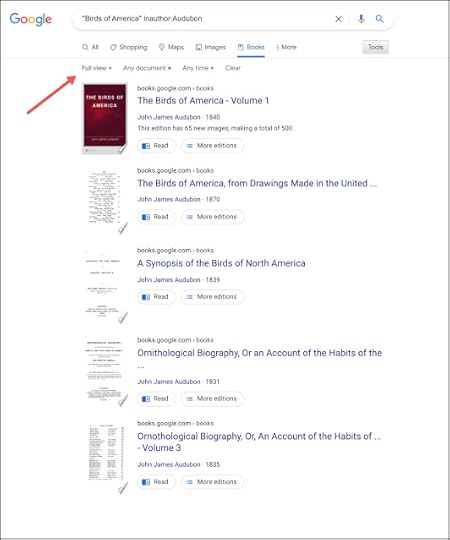
2. Then, open that book (Volume 1) to see this:
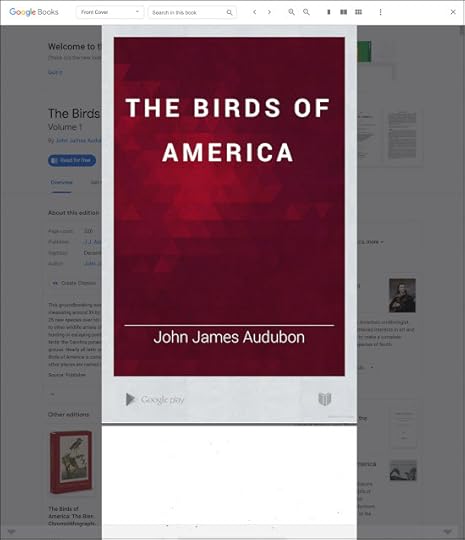
3. Clear the search (you'll see why in the next step). This will then show you the summary page of this book:

4. To find the other volumes of Birds of America, click on the "Other editions" button in the center of the UI:
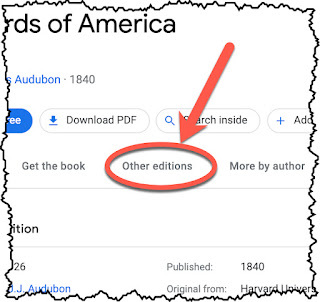
5. Click on "More" -- This will then show you all of the "Other editions" of this book, which will include the option to filter by "downloadable"!

6. Once you click on "Download available," it will show you all of the PDF versions of the books, including nearly all of the other volumes:
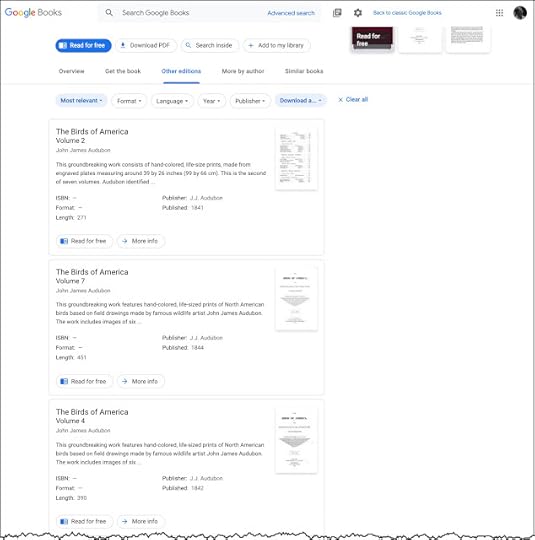
Interestingly, this list now shows you full scans of Birds of America that do not show up in "full view," but which are downloadable (and therefore in full view... go figure).
But I'll tell you now--Volume 5 doesn't show up when you do this search. (It doesn't seem to have ever been scanned.) But the OTHER 7 volumes do show up! And if you're an amateur field biologist, this is a treasure trove for you.
Search on!
Post Script:
If you like this, try the following amazing books, which I leave as suggestions for the interested SRS reader to find:
On the Revolutions of Heavenly Spheres. (aka De revolutionibus orbium caelestium) Nicolaus Copernicus.
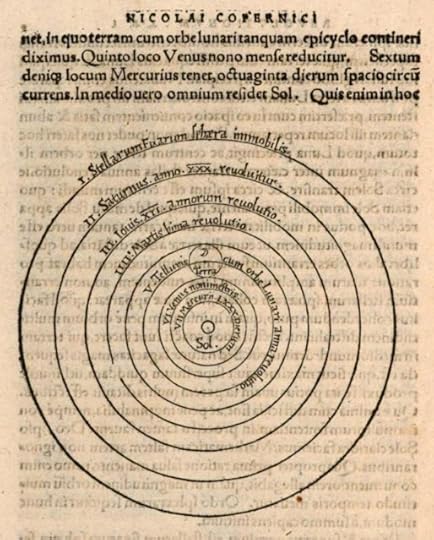
Le operazioni del compasso geometrico, e militare, etc, by Galileo. (1649)
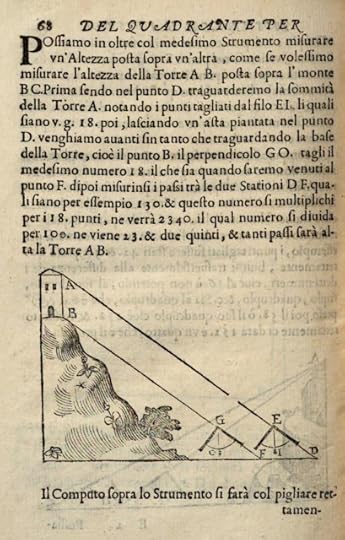
Hamlet, Shakespeare:
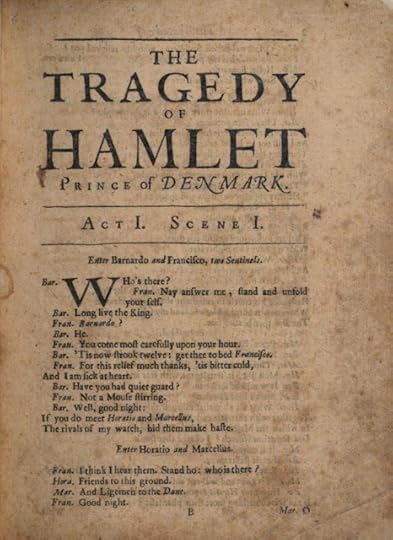
Enjoy!
January 12, 2022
Answer: A new year, a new Challenge about parakeets!
Is it a parrot, or a parakeet, or...
C. c. ludovicianus by John James Audubon. This is the blue subspecies variant of the green/yellow Carolina Parakeet (C. c. carolensis) P/C Wikimedia.
Last week's Challenge was pretty straightforward:
1. ...the Carolina Parakeet, can you find a drawing (or etching or painting) that was done from life? (And yes, I know about the painting in the Wikipedia article. Can you find something OTHER than that?)
I was fascinated by the comments we got about HOW people did their search. Thanks to all who wrote in.Full disclosure: here's what I did...
The straightforward search was: [ Carolina parakeet "from life" ]
and then wander through the images looking for plausible leads. In looking through this collection of results:

I quickly learned a couple of things:
1. the artist Mark Catseby (1682-1749) drew "The Parrot of Carolina and the Cypress of America" c.1722-6. While he was a great collector and he certainly saw live Carolina parakeets, it's unclear if his illustration (see below) was from life... (This image is a fairly low-res version: you can see a beautiful high-res version here, at the Royal Collection.)
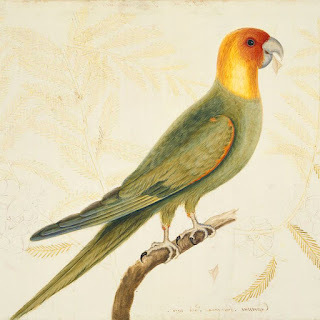 Mark Catseby (c. 1772)
Mark Catseby (c. 1772)2. This bird is also called the Carolina Parrot, which, when you search for it in the manner above, leads to the OTHER Wikipedia image of the Carolina Parrot.
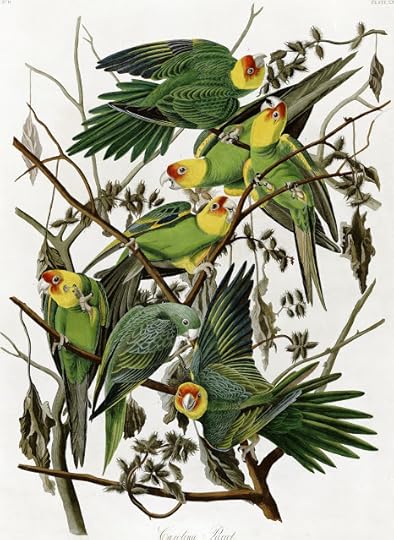 John James Audubon (1833) "from life." P/C Wikimedia.
John James Audubon (1833) "from life." P/C Wikimedia.I figured that John James Audubon (the famous American bird illustrator of the 19th century) probably had done a sketch (or two, or dozens) of this bird. So the simplest search would be to search for Carolina parakeet in Google Books with the date filter set to BEFORE 1918.
I did this... and redid this search multiple times--to no avail! I know Audubon wrote and illustrated a multi-volume work called “Birds of America," and as we see in the above illustration, we KNOW that he painted them at least once, so it was peculiar to not find this in Google Books.
However, once I noticed that the bird was also called the "Carolina Parrot," a search in Google Books for [ "Carolina Parrot ] quickly led me to Birds of North America, Volume 4 (page 306), wherein one finds this image:
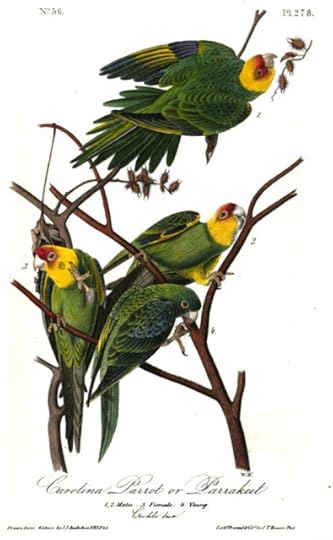 Audubon, "Birds of North America, Volume 4" p. 306
Audubon, "Birds of North America, Volume 4" p. 306 Two things to note here:
First, the Latinate name is, according to Audubon, Centurus carolinensis. Today, of course, it's Conuropsis carolinensis. (Which explains why searching for Conuropsis carolinensis in the works of Audubon didn't work either--he never knew it by that name, nor wrote about it.) Nor did he call it the "Carolina Parakeet" -- he called it either the "Caroline Parrot" OR the "Carolina Parrakeet." Synonyms are great, but they're not perfect substitutes!
Second, in the lower left corner is the notation: "Drawn from nature by J.J. Audubon FRSFLS." Now, we know that "from nature" is about as close to "from life" as Audubon is going to get. As we read in the article, Drawn from Nature , by Laura Harbold,
He spent hours observing birds in their natural habitats, then shot them, using scatter pellets to lessen the damage to their bodies. For Audubon, Eldridge says, "a bird was like a rose. You admired the color, you admired the fragrance, and you picked it without much emotional reaction."
Audubon pinned his specimens to a wooden grid, arranging their wings, tails, and heads in lifelike positions. Using a duplicate grid, he sketched the birds exactly to scale, reproducing each feather to the smallest detail.
And that's what I did to find the Carolina Parakeet (aka Parrot, aka Parrakeet, depending on the source).
Again, thanks to everyone who wrote in with their solution paths.
SearchResearch Lessons
1. "From life" wasn't such a great search term. I didn't know that Audubon (and others) said "from nature"! And, more generally...
2. Sometimes you need an exact match of the search term! Luckily, I noticed that some writers referred to "Carolina Parrot" and I was able to use that term to search in Google Books (and other sources).
3. Looking around (and reading widely) is the best way to zero in on your search target. Search skills are great, but reading broadly, often using lateral browsing, is a great way to find what you see by learning a bit about the topic area.
Search on!
January 7, 2022
Image identification is great, when it works.
Searching by image...
 What plant is this? Can search-by-image help?
What plant is this? Can search-by-image help?... is a fundamental skill for SearchResearchers. You should know how to use regular Google Search-by-Image (see this for a refresher), and you should know how to use Google Lens (refresher), and you should know about Bing's Search-by-Image, Tineye, and Yandex's search-by-image tool as well. That's five major search-by-image systems that you should just know how to use.
But the problem with all of these systems is that they do what they can with what they see, but you shouldn't rely on them for proper identification, particularly of plants, dogs, cats, people, and the random marginalia of life.
Here's what I mean.
This is a photo I took of a plant growing in a nice Silicon Valley bit of landscaping. I happen to know what this is (it's an Arbutus unedo, which we've talked about before in SRS (post about these plants back in 2014). I'm curious to see if Google Lens will identify it correctly or not. I know this is a difficult search because this plant looks superficially like several others. Here, I'm interested in the plant with the red berries and now the low-growing plant below it.
 Original Photo
Original PhotoAs you know, you can select the region of interest in the photo, so I first selected a random bit of leaves, branches, and a corner of one of the fruits. This turns out not to have worked well at all.
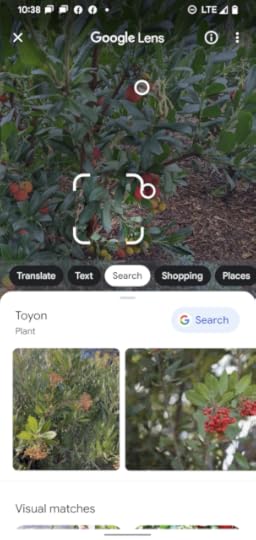
Google Lens thinks it's a Toyon bush, which is reasonable guess, except that the berries are all the wrong size (Toyon berries are much smaller and don't have little hairs). Luckily, I also know what a Toyon bush looks like, so I know it's wrong. But unfortunately, if you didn't happen to know what a Toyon was, you might well accept this an an ID. And you'd be wrong.
For a second attempt, I focused the area of interest onto just the berries. This also turns out to not work well either.
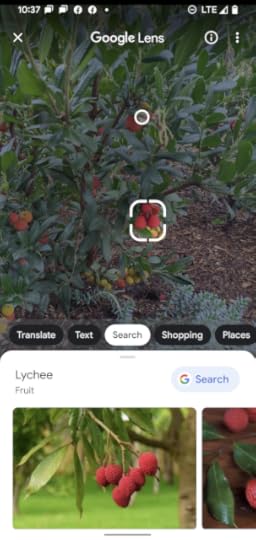
Now Lens thinks it's a Lychee, which isn't a terrible guess, but upclose, they look nothing alike. This is a basic problem with identification only from an image: it's hard to get the upclose details that matter! (For what it's worth, this is a problem for humans trying to identify something from just an image. The key difference is that the human will tell you "I can't be sure, given just this photo" whereas the algorithm just gives you an ID without any indication that there's a possibility of error.
I try again with a broader region to search, and the third time is a charm. Here I've changed the region of interest to be the berry, a few leaves, and a couple of small branches. And this time, it gets it right. Well, kind of. It calls it a "strawberry tree" which is correct and informal. I would have preferred the answer to be more like this:
Arbutus unedo, an evergreen shrub or small tree in the family Ericaceae native to the Mediterranean region and western Europe. The plant is known for its fruit which look a great deal like a strawberry, hence the common name "strawberry tree." However, it is not really related to strawberries at all.
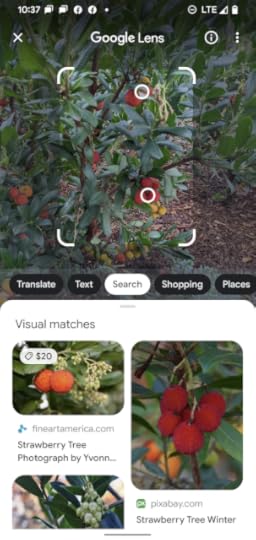
Basically, you have to be careful and check your results. It's tempting to do a quick search and be done with it, but if you're trying to figure out if it's a potentially deadly flower (or berry, or insect bite...), you'll want to do as you always do and DOUBLE CHECK.
Note that all of the search-by-image systems (Tineye, Yandex, Bing, Google, etc.) are all sensitive to the are of interest--you will get different answers depending on which region of the image you ask about.
None of them will tell you about the degree of certainty, but will give you a ranked list, rank ordered by a mysterious relevance operation that probably has nothing to do with accuracy, but more to do with image similarity.
And it should go without saying, but NEVER TRUST a search-by-image function to identify a mushroom. To get a complete ID of a mushroom often requires examining the gills and the spores, frequently with a microscope.
Be aware of the limits of the tools you use--the skilled SRS Researcher knows the limits!
Search on! (Cautiously...)
January 5, 2022
SearchResearch Challenge (1/5/21): A new year, a new Challenge about parakeets!
I started this blog with the idea of writing a book...

... in the very first post I wrote:
In the back of my head, I want something tangible to emerge from this. Ideally, a book, or a series of books, about how people search... how they research... and how they get good at doing this.
While I thought I wanted to write about search (and Research!), I had no idea that this would begin a slow process of transforming me into someone who, in quiet moments of reverie, considers himself to be a writer.
And yet, that seems to have happened. The Joy of Search came out in late September of 2019 with a flurry of sales and activities. At that time, I'd planned an international book tour with invitations to the Oxford Book Festival, the Royal Society in London, and bookstores everywhere. I was hoping to do the full authorial road trip with speaking engagements and book signings hither and yon.
Then March 2020 brought all of that kind of thing to a quick stop as COVID began closing things down. Alas. I'm certain that book sales suffered; I know that my book tour didn't happen in the way I'd planned.
On the other hand, the COVID pause has given me time to think about writing on other projects.
It won't surprise you to know that I'm working on a couple of book projects. First is that series of chapters (with my friend, Mario Callegaro) about "How to Find Anything." (You've seen several of those chapters appear here in SRS. (#1: Finding DIY content. #2: Finding Recipes. #3: Finding News.) By the end of 2022, we'll virtually staple all these chapters together into an e-book for everyone to use. That's one project.
In addition, I started work on a NEW book all about Unanticipated Consequences.
We know humans are terrible about seeing the implications of taking actions in the world, but can we get better at thinking through these things? Could we actually anticipate the consequences of our actions instead of just blindly letting them happen? (Spoiler warning: Yes we can, but you'll have to read the book to find out how!)
This book is probably about 1 year away. But just as I started the SRS blog with an eye towards writing The Joy of Search, I'm similarly starting up a new Substack newsletter to give me a way to write on this topic with a regular, weekly pulse. If you'd like to follow along in that conversation, you can read the first post HERE (it's free to subscribe--hit the big orange button at the top of the page).
But that's all prologue. Let's get back to SearchResearch!
As you might have noticed, sometimes the SRS Challenges are really fairly difficult. (Boy do I know THAT to be true!) And a few regular readers have commented to me that while those are interesting to read, they don't really participate because it seems too hard. That's not the effect I'm looking for, so I'm going to try something slightly different for January, 2022. We'll try putting out a few SRS Challenges that are fun, fairly straight-forward, but as interesting as ever. My hope is that we'll engage everyone to try the Challenge, and learn something interesting along the way--both about research skills, and about the world in general.
So, in that spirit, here's the first Challenge. Let me know if you find this interesting / more fun / perhaps a bit more engaging that the ones from 2021.
1. As you know, I'm interested in natural history, and also in regular history--and also in the ways those two intertwine. You probably already know about the now-extinct Carolina Parakeet (Conuropsis carolinensis). It went defunct around 1918, right during the Spanish Flu epidemic. And so while there are a (very) few stuffed specimens of the Carolina Parakeet, can you find a drawing (or etching or painting) that was done from life? (And yes, I know about the painting in the Wikipedia article. Can you find something OTHER than that?)
 C. c. ludovicianus by John James Audubon. This is the blue subspecies variant of the green/yellow Carolina Parakeet (C. c. carolensis) P/C Wikimedia.
C. c. ludovicianus by John James Audubon. This is the blue subspecies variant of the green/yellow Carolina Parakeet (C. c. carolensis) P/C Wikimedia.
This shouldn't take too long to do, but will reward you with a few lovely images that are not often seen.
Let us know what you find!
Search on!




